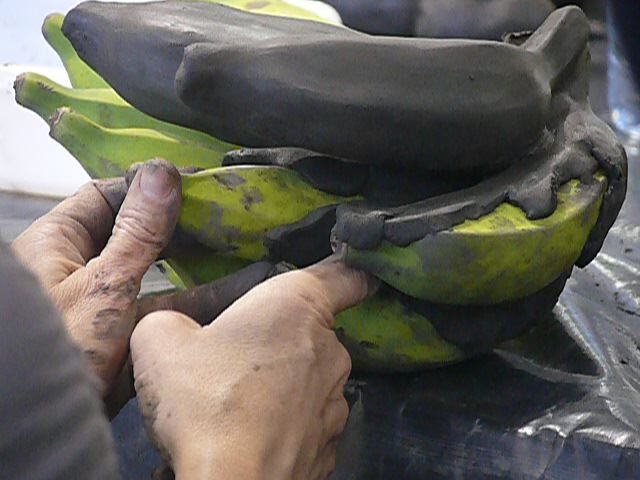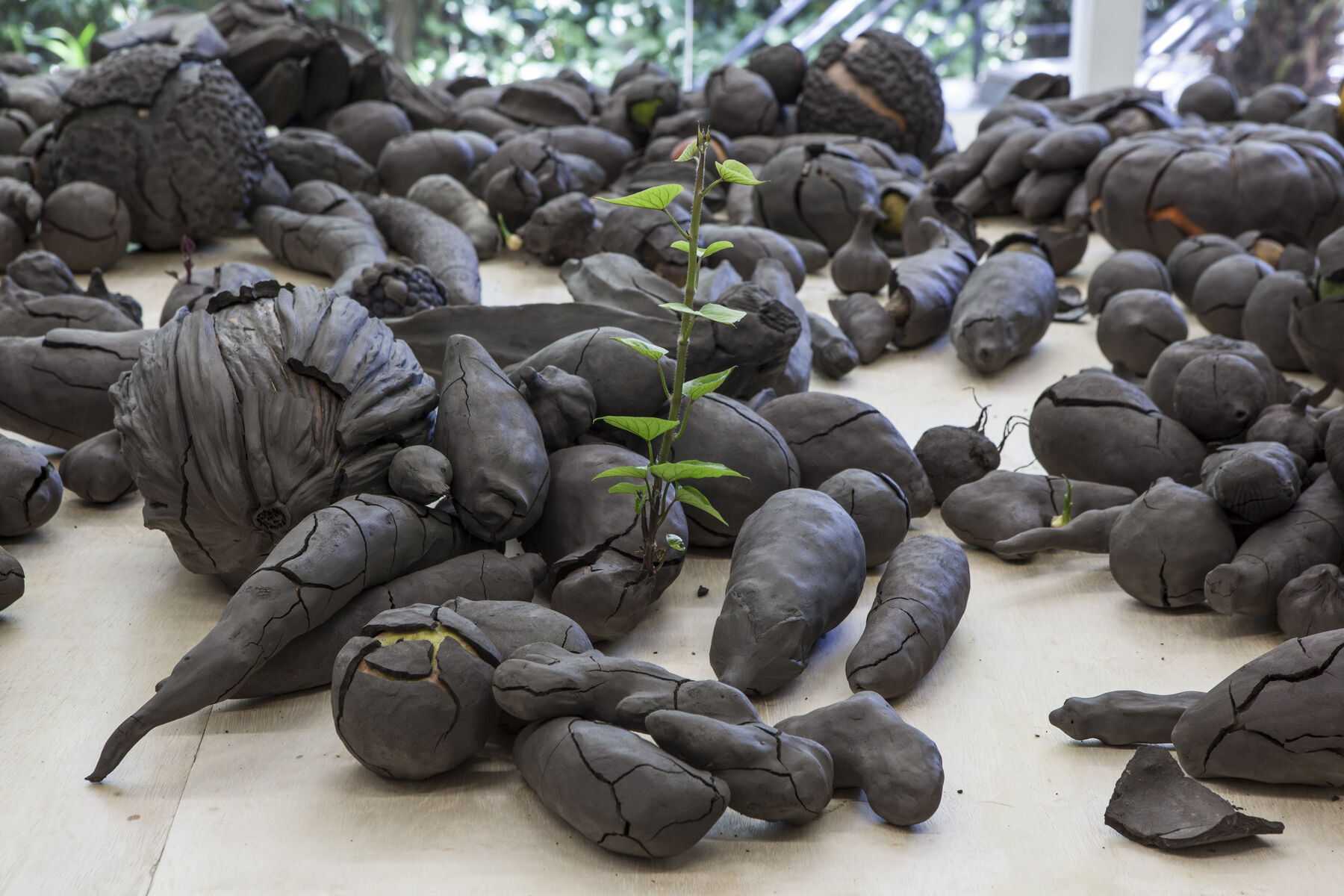9. The Life-Death Movement of Fruits, Tubers, and Vegetables in Nydia Negromonte’s POSTA
- Magali Melleu Sehn
Nydia Negromonte (b. 1965) is a visual artist born in Lima and presently living in Brazil. She graduated from the School of Fine Arts of the Universidade Federal de Minas Gerais with a specialization in graphic arts and has participated in numerous exhibitions in Brazil and abroad. Some of the artist’s installations illustrate the idea of exploring, participating in, and collaborating on changes affecting matter, as in the ongoing work POSTA, an art installation made from clay-enveloped fruits and vegetables arranged on a wooden table. Over time, the objects change: the fruits and vegetables either grow or wither, and the clay dries and cracks, revealing the temporality of the objects and the transformations that occur to them due to (favorable or unfavorable) characteristics in the environment. According to the artist, this work investigates the movements of “vigor and decay”: some of the objects sprout, others decompose, and yet others dry up.1 The curator and critic Jorge Villacorta Chávez has written about POSTA:
Temporality is a crucial factor in these works by Nydia Negromonte. The artist suggests that time must be allowed to do its part. Thus, the growth and life force that breaks through the clay enveloping the fruits and vegetables brings us face to face with a dimension in which processes take place that we don’t keep any record of at all (or which we only identify in order to discard the matter undergoing transformation). This reveals the power—and fragility—of the process of memory if we pay attention and cultivate it. (, 3)
POSTA Exhibition History
POSTA has been shown in five exhibitions to date: Lección de cosas (Lesson of Things), curated by Renata Marquez at the Museu de Arte da Pampulha, Minas Gerais, Brazil (2012); A iminência das poéticas (The Imminence of Poetics), curated by Luis Péres-Oramas, 30th Bienal de São Paulo (2012, fig. 9.1); Palácio das Artes, Belo Horizonte, Brazil (2013); Centro Cultural Chacao, Caracas, Venezuela (2013); and Lección de cosas, curated by Andrea Elera and Jorge Villacorta Chávez at Sala Luis Miró Quesada Garland, Lima (2018, fig. 9.2). At all of these locations, the work was mounted following a script, which consisted of the artist selecting fruits and vegetables from local markets, having assistants encase them in clay, and arranging the wrapped vegetables on a table designed by the artist. Although the same procedure was followed each time, the vegetables naturally had different reactions and behaviors of expansion, retraction, and stabilization. These movements, some anticipated and others not, added symbolic meanings.
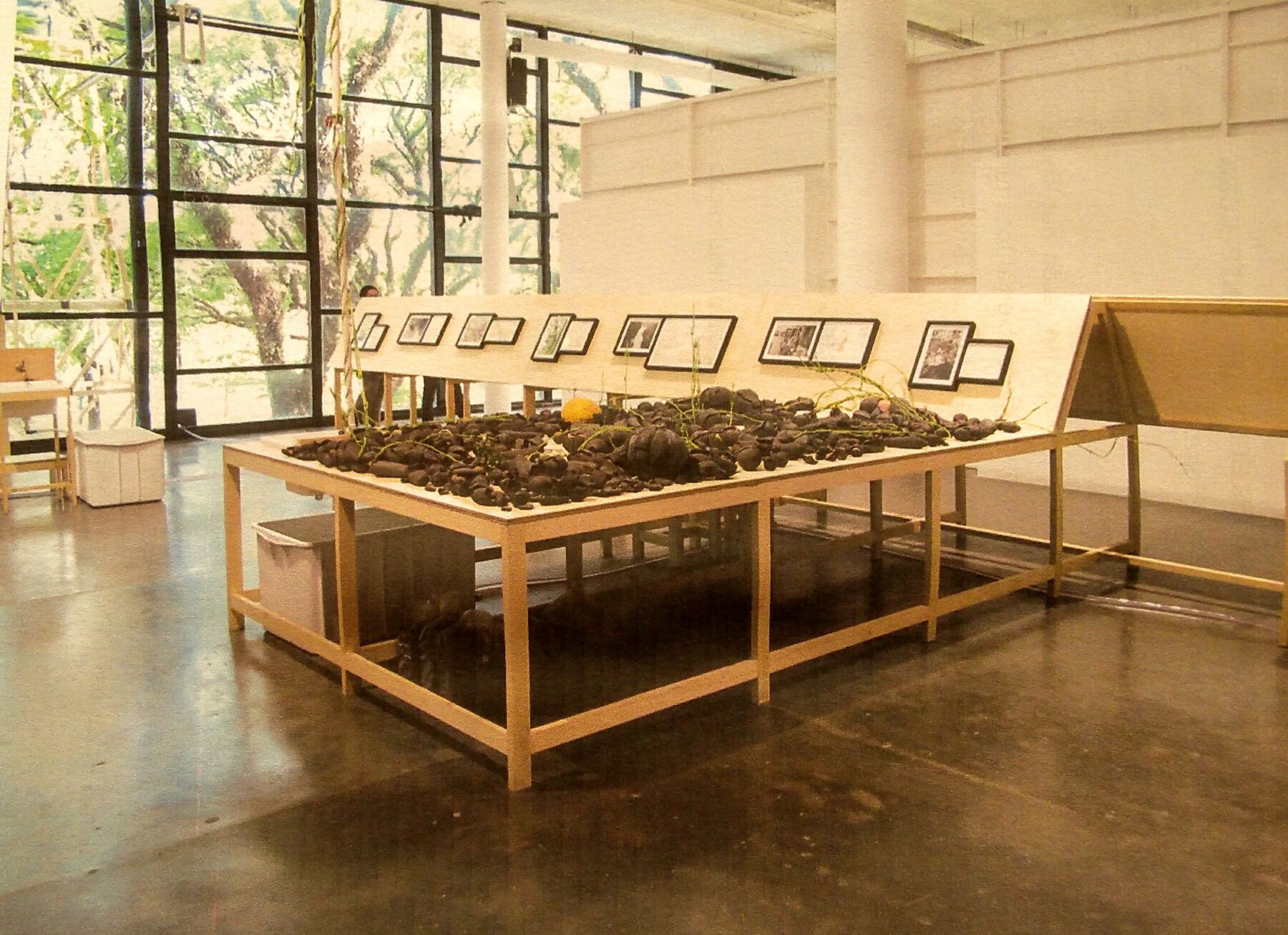 Figure 9.1
Figure 9.1 Figure 9.2
Figure 9.2The selection process for the fruits and vegetables is based on somewhat loose criteria, such as shape and color; vegetables that will sprout; vegetables that won’t sprout; and affordability (what might be cheap in one state or country can be expensive in others). The next step is to instruct the assistants in the process of encasing the fruits and vegetables in a black clay, or when that is unavailable, a locally sourced clay with similar composition and color. At this stage, the artist conveys technical information, such as how to handle the raw clay, emphasizing the importance of “form rather than texture” (fig. 9.3). During the process, the artist offers discussions on art and the works of the participants, who are almost always art students, friends, or teams hired by the institution where the exhibition is taking place. Lastly, the artist arranges the pieces on the simple, unvarnished wooden table, laying out the large pieces first and then the medium and smaller ones, thereby creating a composition. The artist carries out this part alone (fig. 9.4).
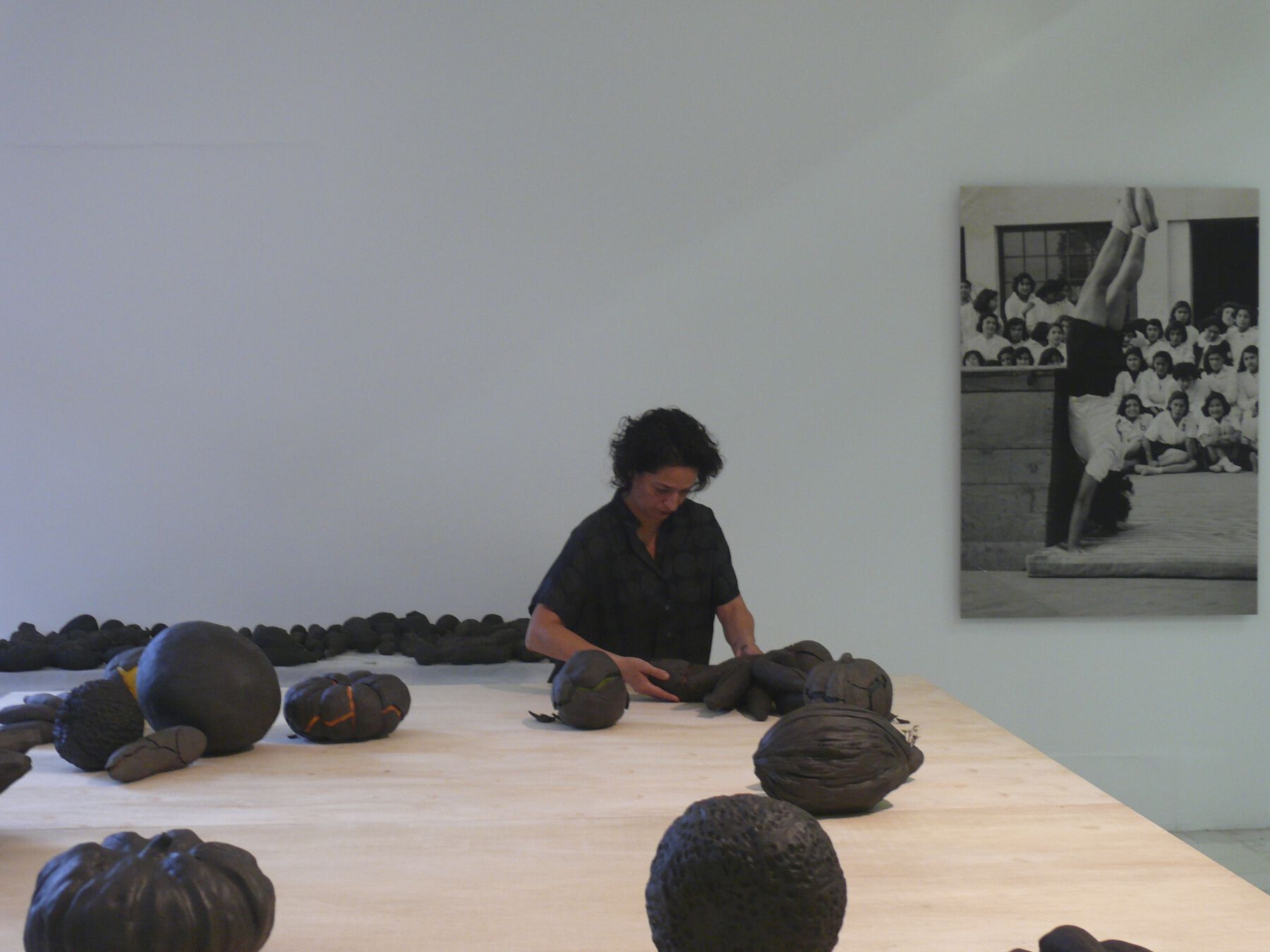 Figure 9.4
Figure 9.4The artist notes: “The most interesting thing about this work is that it invites observation. People spend a long time looking, trying to identify what something is, what it is not, if it is sprouting, if it is smelling. The banana, for example, smells not like rot, but like it is roasted, and it dehydrates, like a banana-raisin.” The installation requires replacement of selected materials so that the transformations happen according to the artist’s intention, although across the spectrum of transformations, some are expected and others are not expected, but accepted by the artist. The artist’s experience with the transformation of materials at each exhibition expands her understanding of the reaction of materials in different contexts. The vegetables that dehydrate and stabilize might even be used in another exhibition. And excess clay fragments that break during the germination process are removed to avoid unwanted noise.
The Movement of Life and Death: Vigor and Decay
According to the artist, new conceptual and practical issues arise each time the work is installed. As an example, she cites her experience with potatoes, which generally decompose and start to smell bad and thus were at first mostly avoided. But when she was mounting the work in Peru, it felt impossible to omit potatoes, considering that the region has such an enormous variety of them. As a result, she indicated that in future installations no fruit or vegetable should be systematically avoided. What is important is the movement of “vigor” that is represented in life through flowering and expansion (fig. 9.5) and the “decay” that is represented in decomposition, desiccation, withering, and death (fig. 9.6, fig. 9.7). Some types of produce, such as ginger and potatoes, sprout more than others. Others, such as cucumbers and watermelons, contain a considerable amount of water and have to be removed after a time to prevent disrupting the entire assemblage. Others, such as star fruit, dry up and stabilize: “It is a work comprising two opposing forces, decay and vigor. These two forces are essential. Thus, in future mountings of the work, I won’t use just star fruit because life isn’t like that, it’s not made solely of things that bear up well under adversity.”
POSTA employs ephemeral, organic materials that undergo transformations over time, and each fruit or vegetable responds differently to being enveloped and imprisoned, testing its capacity to free itself to sprout and expand. Through the various processes of selecting vegetables, encasing them, and observing transformations such as changes in appearance and shape, one can understand the symbolic meanings that change with each movement of vigor or decay. The concept is preserved through continual replacement of materials during each exhibition, and by making the selections in keeping with the specific context, which allows for observing new reactions.
The work poses a number of questions when considering its viability for a long-term exhibition: What would be the parameters and limitations of maintenance, partial replacement, or reconstruction? Generally, potential permanent acquisition is feasible in the same way that many other works made from ephemeral materials have been acquired—namely, the purchase of the project must include instructions regarding the materials, the assembly process, acceptable methods of exhibition and interaction with the public, and an artist’s statement about its conceptual and material aspects. There is already a general consensus on these protocols among professionals and institutions that acquire complex collections of contemporary art. But based on the artist’s observations during the new iterations of the work in different spaces and climates, some desired and some undesired outcomes have already been encountered that affect the work as a whole.
What limitations are presented by the sprouting and expansion of the plants and the interactions among them? What limitations are entailed in desiccation and shrinking and emanation of odors? What limitations are involved in the elimination of the fragments of clay that break off during the sprouting process? The answers to such questions depend mainly on the context and how each institution can continually update preestablished protocols for the work’s maintenance and criteria for ongoing replacement. Regarding maintenance, the artist suggests
a daily review to find fruits or vegetables that may have decomposed (leaking liquid or foul odors) and eliminating them along with their fragments. If they exhibit very disagreeable odors, spray the moldy parts with an antibacterial spray, but avoid spraying nearby vegetables that are in the process of sprouting. In the event of replacement, wrap the replacement item in raw clay one centimeter thick, seeking fidelity to the shape rather than the texture.
The maintenance instructions are based on her experience viewing the work in temporary exhibitions that generally do not exceed three months. If the work is acquired by an institution to be on permanent or periodic display, factors that will need to be considered include: having a team of professionals capable of reconstructing the work for each exhibition; financial conditions for continued maintenance and replacement; and appropriate location and space so that the work doesn’t interfere with the welfare of other works in the collection.
Although the artist says that the process begins with her own selection of fruits and vegetables in local markets, she does note that if an institution purchases the work and reconstructs it in the future without her being present, all the other instructions should still be followed in this manner:
Select varied fruits and vegetables, considering shape and color—some that sprout and others that don’t
Have a team wrap the fruits and vegetables, emphasizing shape over texture
Display them on a table designed by the artist specifically for exhibiting these pieces
The wrapped fruits and vegetables must be laid out by only one person, using the following order of distribution: the large fruits and vegetables first, then the medium-size ones, and lastly the smallest ones
Limitations on expansion of fruits and vegetables that sprout will depend on the context in which the work is exhibited
Limitations on the permanence of the fruits and vegetables in the desiccation process will depend on how much they disrupt the work as a whole
In the event of permanent acquisition by an institution, the exhibition duration will be determined by curatorial proposals, since interactions can occur ad infinitum through continual replacement of the fruits and vegetables
At the end of each exhibition, the institution may choose to completely discard even the pieces that have stabilized
The work may be displayed in simultaneous exhibitions
For observation purposes, the artist still keeps some fruits or vegetables today that have stabilized. During the exhibitions, documentation is carried out on some transformations, which resulted in another work titled Post POSTA Series (2014, fig. 9.8), a photographic essay of POSTA fruits and vegetables carried out during the dismantling of the installation after the 30th Bienal de São Paulo (2012).
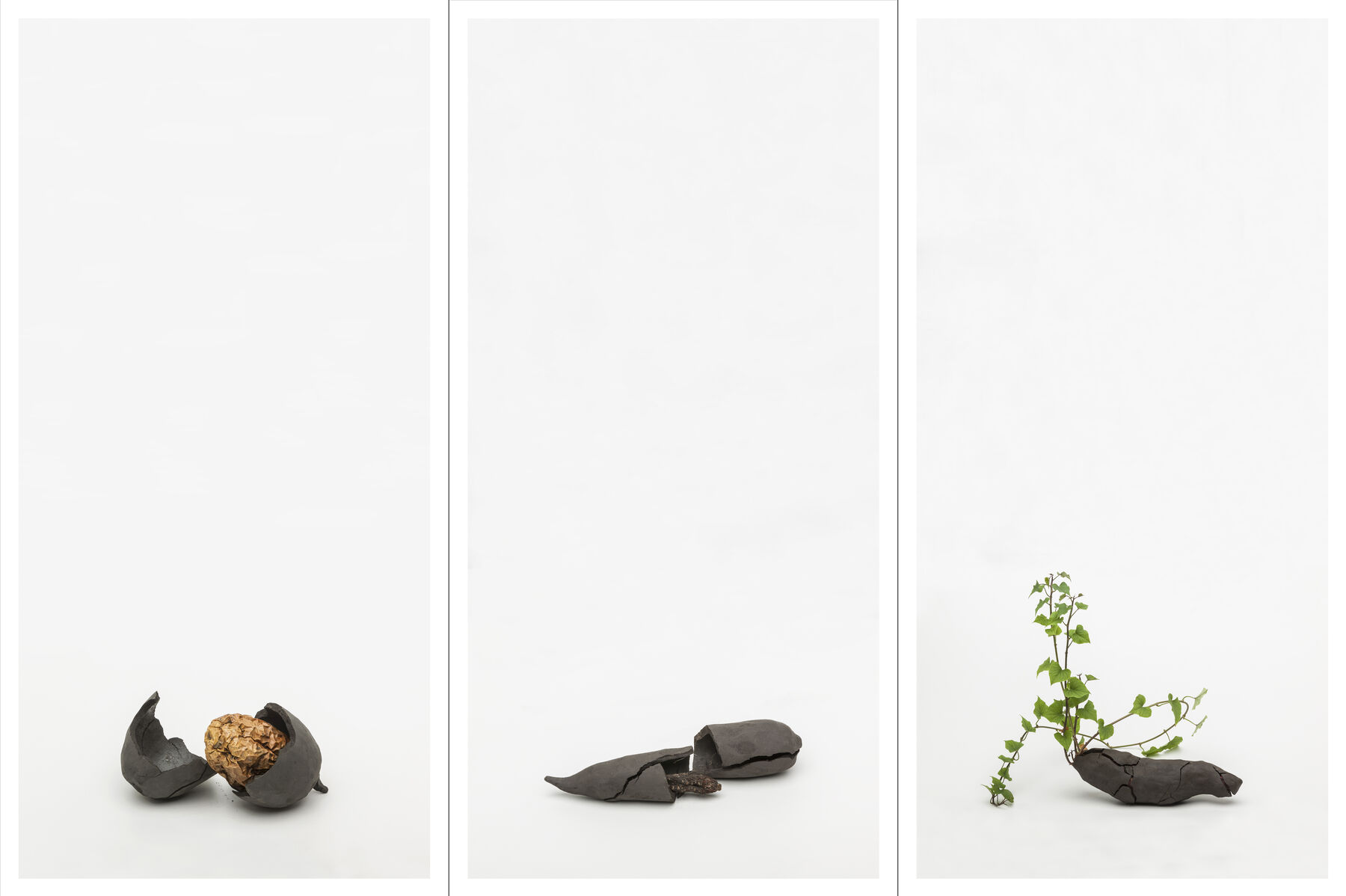 Figure 9.8
Figure 9.8The Potential for Long-Term or Permanent Acquisition
Regardless of whether the work will be acquired by an institution or not, it is extremely important that conservators, working with the advice of an institution, take part in the main phases of evaluating a long-term loan or permanent acquisition, including maintenance capabilities. Other professionals to consult should be trained in preparing documentation and intervention protocols; drawing up contractual agreements that consider the transformation of materials; remaining in contact with the artist for potential changes in her stance over time, and other considerations.
My 2013 article “El problema de la conservación de arte contemporáneo en el contexto de los préstamos a largo plazo” (The Problem of Conserving Contemporary Art in the Context of Long-Term Loans), which treats loans of up to twenty years, partially assesses the problem of long-term acquisitions of contemporary art and the role of the conservator in drawing up contractual agreements, which is an acquisition practice in Brazil. In an interview I conducted for that article, curator Felipe Chaimovich emphasized the importance of long-term loans to evaluate whether the work in question definitely fits an institution’s mission statement and collecting policies, and to evaluate whether a museum has adequate technical facilities for maintaining the work. The matter is complex, but it is a practical intermediate step toward a permanent acquisition (, 89). In the case of POSTA, the concept encompasses the process, the symbolic meaning of the materials, and the transformations in shape and appearance that, in the case of a long-term or permanent acquisition, entail the preparation of detailed protocols.
In spite of the many existing bibliographic references regarding issues surrounding the preservation of contemporary art as a reflection on criteria, methodologies, documentation, and so on, conservators are continually struggling with opposing forces during the decision-making processes that will also affect the life and death of the work. POSTA, with its literal and symbolic balance between movements of vigor and decay, in this way offers possibilities for maintaining vigor in particular.
Acknowledgments
Many thanks to Nydia Negromonte for a highly productive conversation in her studio, and for making photographs available from her personal archive; to the Graduate Program of the Universidade Federal de Minas Gerais; to PPGARTES and PROEX for their financial support for the presentation in Mexico; and to the organizing and editorial team for the “Living Matter” symposium.
Note
All artist quotes come from a 2018 interview with the artist in her studio, later supplemented by email and telephone conversations. For more information on the artist visit https://nydianegromonte.com/. ↩︎
Bibliography
- Chávez 2018
- Chávez, Jorge Villacorta. 2018. “A Presentation.” In Lección de cosas. Lima: Sala Luis Miró Quesada Garland. https://www.academia.edu/36890339/Nydia_Negromonte.
- Cologne Institute of Conservation Sciences and Technology Arts Sciences 2019
- Cologne Institute of Conservation Sciences and Technology Arts Sciences. 2019. The Decision-Making Model for Contemporary Art Conservation and Presentation. Rev. ed. Cologne: Cologne Institute of Conservation Sciences and Technology Arts Sciences. https://www.th-koeln.de/en/decision-making-model-for-contemporary-art-conservation-and-presentation--revisited_63959.php.
- Macedo and Henriques da Silva 2010
- Macedo, Rita, and Raquel Henriques da Silva, eds. 2010. A arte efímera e a conservação: O paradigma dos bens etnográficos e da arte contemporânea = Ephemeral Art and Conservation: The Paradigm of Contemporary Art and Ethnographic Objects. Lisbon: Instituto de História da Arte, IHA FCT-UNL. https://run.unl.pt/bitstream/10362/16429/1/Livro_Actas_Completo.pdf.
- Negromonte 2016
- Negromonte, Nydia, ed. 2016. D.U.C.T.O: Nydia Negromonte. Belo Horizonte, Brazil: Autêntica.
- Sehn 2013
- Sehn, Magali Melleu. 2013. “El problema de la conservación de arte contemporáneo en el contexto de los préstamos a largo plazo,” 87–94. Conservación de arte contemporáneo 14. Madrid: Museo Nacional Centro de Arte Reina Sofía.
- Sehn 2014
- Sehn, Magali Melleu. 2014. Entre resíduos e dominós: Preservação de instalações de arte no Brasil. Belo Horizonte, Brazil: C/ARTE.
- Wharton et al. 2016
- Wharton, Glenn, et al. 2016. “The Artist Archives Project: David Wojnarowicz.” In Saving the Now: Crossing Boundaries to Conserve Art Works, edited by Austin Nevin et al., 241–47. Los Angeles and London: Studies in Conservation (IIC).
